Peas are cold-weather vegetables that thrive in spring and autumn. The two different types of Peas are shelling Peas and edible-podded Peas. Shelling Peas are grown for Peas hidden inside the pod. Throw away the pod once it’s shelled. You can eat Peas with edible pods whole, pods and all.
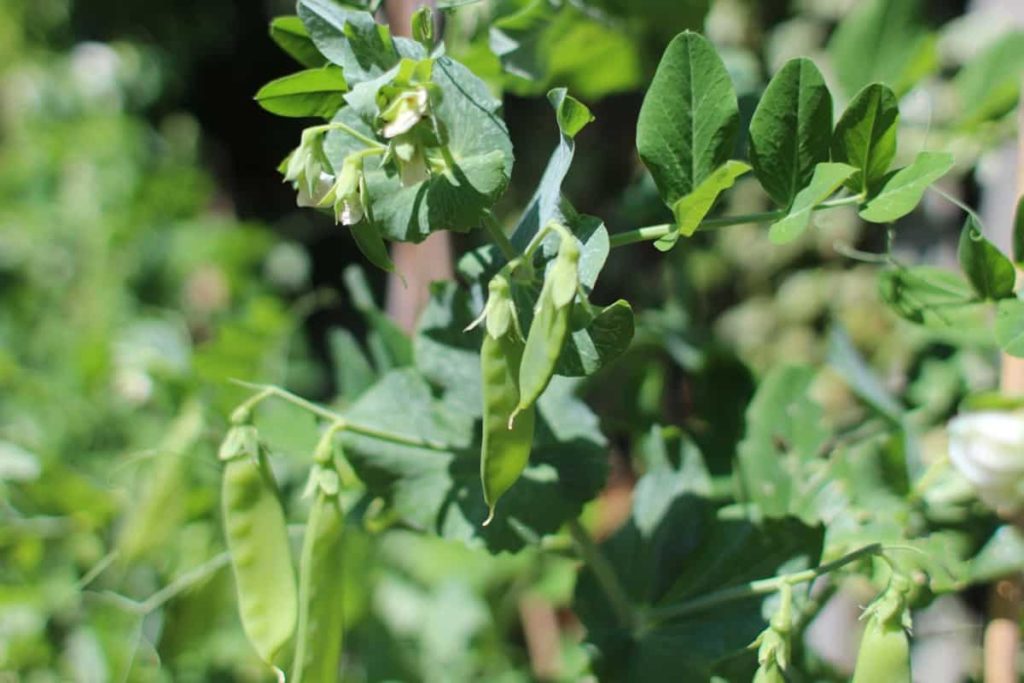
Peas can be grown in raised beds or borders, and they can happily live in pots on the patio or balcony. Although they require a little effort, they are not difficult to grow, so give Peas a chance in your kitchen garden plans. Growing Peas from seed are easy, but their growing period is minimal. It is essential to plant them early enough in the spring so that they mature while the weather is still cold.
How to grow Peas from seed to harvest
How long does it take for Peas to grow from seed to harvest?
- It is easy to grow Peas if the weather is cold enough. Peas can usually be harvested between 12 and 15 weeks of planting. Rotate your Pea crop every other year. Continuously harvest beans to encourage further growth. When harvesting, you should secure the vine with one hand while pinching the Peas with the vine using the other hand.
- Once the plant’s production stops, it is advisable to dry by leaving some beans on the plant and some seeds for next year’s sowing. Peas, flowers, and fruits will grow in about 10 to 14 weeks, depending on the types. It can take three weeks for Peas to mature from bloom to pod.
- Most varieties of Peas require about 60 days of growth before harvesting. But they will stop growing and won’t grow flowers or beans once the temperature rises above 30°C, as is often the case in June. However, if you harvest all the beans when young, the Pea plant can continue to produce continuously for 2 to 3 months or more.
How do you know if Peas are ready to harvest?
- Peas should be ready for harvest three weeks after flowers appear. Shelling Peas are ready when the pods swell and are almost cylindrical. Peas mature quickly, so check daily once you see the flowers bloom.
- Pick snow Peas when delicate beans start showing immature seeds inside. Collect snap Peas when the beans become thick yet are shiny and filled with sweet-tasting Peas. Pick shelling Peas before the beans waxy.
In case you missed it: Growing Pigeon Peas In Container – Planting Guide
How many Peas will one plant produce?
Usually, Pea plants produce 5 or 6 Peas per pod. Suppose the Pea plant had five pods and a total of 26 Peas. The average yield is 2.5 to 3.5 tonnes per hectare. The yield of Peas in pods is an average of 5 or 6 tons of pods per hectare. Edible podded Peas usually yield 3 to 5 tonnes of beans per hectare.
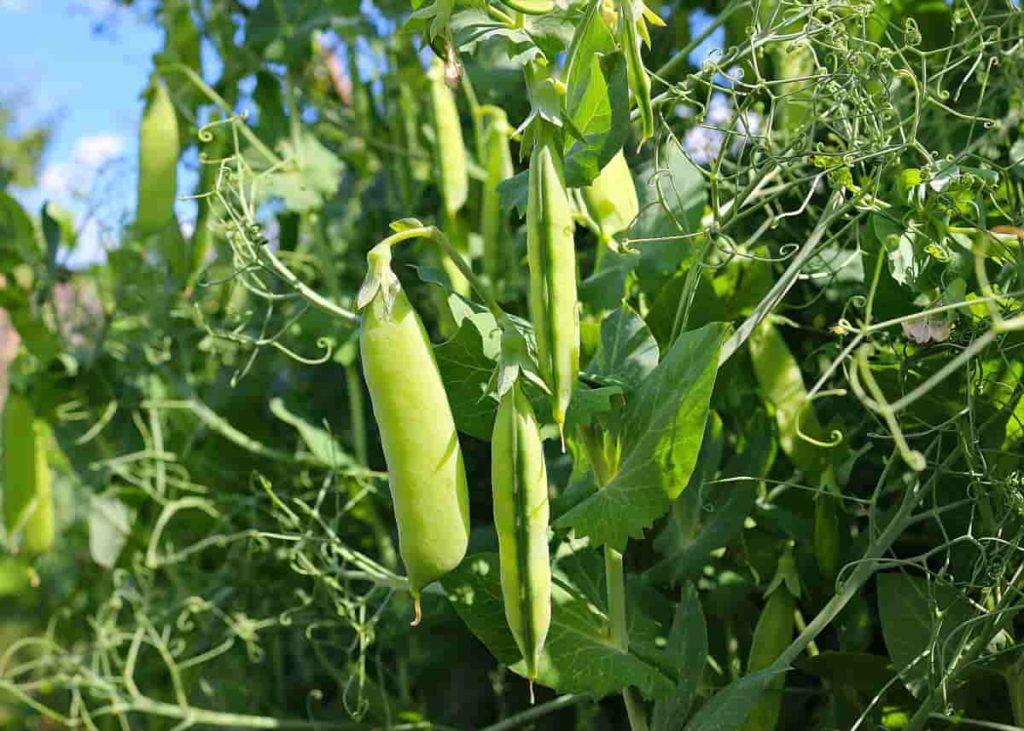
What month do you plant Peas?
- Sowing time for Pea seeds depends on the area of cultivation. The rabi season crop sowing usually begins from October to November in India’s plains. In the hills, it will be from mid-March to the end of May. Seed sowing is preferred during the first week of November to achieve higher yields.
- In India, winter is an excellent time to start sowing Peas. They usually enjoy a slightly cooler climate but nowhere near a frost. Also, if you want a steady and fresh supply of Peas in your garden, sow every two to three weeks.
- The growth of Peas is very easy, but their growing period is minimal. It is essential to plant them early enough in the spring so that they mature while the weather is still cool.
- Plant Peas during the mild season of early spring once the soil temperature reaches 8°C. Once spaced, young Pea plant in an area 5 inches apart with an abundance of sunny, fertile, well-drained soil. Improve your native soil by mixing in several inches of aged manure or other rich organic matter.
How many times can Peas be harvested?
- If you’re growing dried Peas, take a few harvests of fresh Peas and then let the plants mature and dry as they follow their natural path. When you stop picking fresh Peas, the plant will stop over-producing.
- The entire harvesting time of Peas usually lasts from one to two weeks if all Peas are planted simultaneously. Harvest more frequently than necessary to remove all Peas from the vines. Successive plants allow for a steady supply of seeds and hulls for harvesting. Most varieties of Peas require about 60 days of growth before harvesting. But they will stop growing and won’t produce flowers or pods once the temperature rises above 30°C, as is often the case in June.
Do Peas need a lot of water?
- Since Peas grow during wet and colder times of the year, you may not need to water them at all. During dry springs, you may need water to grow good Peas. You should water the soil, not the vines, to avoid disease. Soak the soil while watering at least an inch deep every week during the growing season.
- Pea plants thrive when 1 inch of water is given each week. You don’t have to water your Peas every day. You should not dry the soil completely, or it will drastically reduce the production of Peas. The critical time for watering is when plants bloom and produce pods. Water daily to maintain the pod’s quality when the beans are maturing in hot weather.
- You can overwater Peas more easily. When this happens, the leaves wilt, the roots rot, and the plant die. Peas that don’t get enough water also wilt and die. Therefore, finding the correct balance and adapting to weather changes is important.
- Water the Pea plants when the top 1 inch of the soil starts drying up. Apply water directly from the garden hose to the ground around the plants. Avoid spraying too much moisture on the plants. You should water the plants in the morning, so the leaves have time to dry before nightfall.
Do Peas need sun or shade?
- Peas need sun for about four to five hours daily to produce flowers and pods, but they fade away as temperatures warm up. Planting them in a cool shady place will lengthen your growing season.
- Pea plants are partially shade tolerant, but they perform best in full sunlight. Planting them in a complete shade will likely result in slower growing times and poor overall growth. If adequate daylight is not given to Peas, expect small yields if they also produce any Pea pods.
- Peas grow best and faster if they get enough sunlight during the day. This usually means between 6 and 8 hours. However, they do not tolerate hot temperatures well and can get too much sun in hot areas. If Pea plants get too much sun, they can start to wilt, and the leaves can turn brown.
In case you missed it: Growing Organic Peas In Containers – Tips, And Ideas
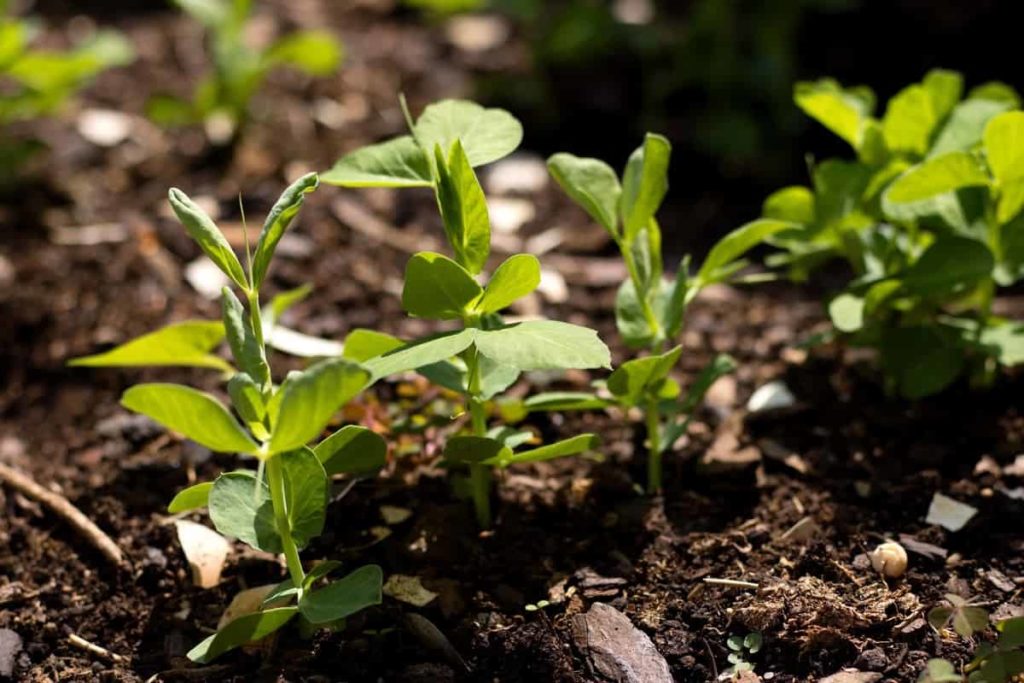
Where do Peas grow best?
- Choose a sunny location and well-drained soil. Although Peas can grow in partial shade, they will not be as sweet or productive as those grown in full sun. Prepare the soil, preferably in the fall, mix in aged manure and compost, and very well. Peas grow well in drained soil.
- Peas favor a cooler climate with average temperatures of 10°C to18°C during their growth. Seed germination occurs when the temperature is less than 5°C at the planting time. Peas can tolerate frosts in the early stages of growth.
Do Peas need fertilizer?
- Peas grow best in a soil pH between 6 and 7.5. Use well-decomposed manure or compost in planting. Continuous use of more phosphorus fertilizers, such as 10-10-10 or 15-30-15, or higher rates of manure or compost results in phosphorus formation in the soil.
- Peas usually require little or no fertilizer when grown in soil. However, if grown in a container, a light dose of fertilizer for fruiting, such as 5-10-10, can be applied at the beginning of their development.
- Peas prefer less nitrogen, more phosphorus, and more potassium fertilizers such as 5-10-10.
- Peas need a sunny, nutritious, moisture-rich site. You can dig the soil and add compost or well-decomposed manure; this will help improve the soil’s ability to retain moisture in hot, dry summers.
- Water the Peas regularly while keeping the soil evenly moist. Grow tall Peas on poles, fences, or trellis. You should give complete fertilizer to Peas six weeks after planting; no fertilizing is necessary for soil prepared with well-decomposed manure and bone meal.
- Fertilize when you usually water your Pea plants anyway. It’s usually best if you only fertilize Peas once during their life cycle. If you fertilize too much, the plants will produce large vines and leaves at the expense of producing a pod.
Do you soak Peas before planting?
- Place the amount of Pea seed you want to plant in a cup of lukewarm water overnight in your garden will help the seeds absorb water and reduce the amount of time needed for them to germinate.
- Some Peas seeds will look wrinkled. Most are tight coats, and all benefit from soaking before planting. Soak them in warm water overnight. This process will speed up the process of germination.
Can you plant Peas too close together?
- Pea plants should be kept at a distance of 1 to 2 inches. Over-planting reduces air circulation and makes your plants more prone to fungus.
- You should sow Pea seeds 1 inch deep and about 2 inches apart. Don’t thin. Plant rows 7 inches apart. Do not plant Peas more than once in the same place every four years, depending on crop rotation.
- The space rows of Peas are at least 18 inches apart. Usually, the germination occurs between 7 and 14 days.
Why are my Peas not producing?
- Any poor growing conditions can also be attributed to the garden not producing Peas. Poor weather conditions can hinder the growth of root nodules and prevent nitrogen-fixing. If you plant Peas too late in the season, plants turn yellow and die before setting pods.
- The simplest explanation for empty Pea pods is that they are not mature yet. Peas plump up as the pods mature, so try giving the pods a few more days.
- The soil around your Peas should remain consistently moist, and that may need deep watering two or three times weekly, depending on the rainfall. Proper trellising is also key. But the easiest way to increase your production is to get an inoculant when planting.
Why arent my Peas blooming?
- When Peas are all leaves with little or no flower growth, too much nitrogen is often the problem. Get the garden soil tested and fertilize only if nitrogen levels are low. Use less nitrogen fertilizer, like 5-10-10 around Peas.
- Your Peas do not often bloom due to lack of sun, high temperature, or too much fertilizer. Sweet Peas flower excellent in full sunshine, medium to low nutrient soil with regular water. Heat waves can also prevent them from blooming temporarily.
- If your plants aren’t flowering, it may be that they’re not getting enough light; they need 8 to 10 hours daily.
In case you missed it: How to Grow Green Peas from Seeds (Matar) at Home

Do Peas produce all summer?
- Pea plants are annuals that enjoy the cool spring season but prevent production and death in warm summer temperatures. For the best results, you should harvest your Pea plants before the outdoor temperature warms to 22°C.
- Peas are cold-weather plants. They perform best in the cold spring. When the summer heat arrives, Peas begin to dwindle. Their growth slows down; the leaves can turn brown and production stops.
Should you prune Pea plants?
- Although Peas don’t need much pruning, many will prune a small number of Pea tendrils or shoots.
- Cut off the growing tip of your climbing Pea vines once they reach the limit of your trellis. The process is simple, just take a sharp pair of scissors or pruners and clip back the top of each plant to a leaf axis just above the top of the structure.
Do Peas need deep soil?
- Pea plants have relatively shallow roots and don’t need a huge deep garden; they are the best vegetable to grow in containers. Growing Peas in pots on rooftops, in your backyard, or even on a small balcony is easy.
- Pea plants only need an eight-inch soil depth so that you can choose a shallow, wide container, such as a windowsill planter box. The container should contain proper drainage holes and good air circulation to ensure that the root system does not sit too much in the water.
What makes Pea leaves turn yellow?
- The rapid growth after the stressful growing condition is often the reason for the yellowing of the new leaves of Pea plants. Rain after a dry period or hot weather after a cold period is at times when new leaves are likely to turn yellow.
- If your sweet Pea leaves turn yellow, it’s usually an indication that more water has been given under the plant. Another reason could be too rich fertilizer, which causes the plant’s root burn.
Do Peas need a trellis?
- Peas come in two heights bush Peas and climbing Peas. Although the bush Peas are only 2 to 3 feet tall, they will flop on the ground if you don’t give them anything to climb. Climbing Peas can be 6 to 8 feet tall and need a sturdy trellis.
- Green Peas don’t need a trellis, but they will be easier to pick when the vines are kept upright. If you’re using a trellis, insert it before planting. Use netting, steaks, and strings, a wooden frame covered with chicken wire, metal fencing, or a collection of twiggy branches stuck in the ground between plants.
- The height of your trellis will depend on the size of the Peas you’re growing. Snow Peas are not very long, so the trellis can be 4 to 5 feet long, but most regular Peas need a 6 to 8 feet long trellis.
- Peas can be successfully grown without trellis by selecting a dwarf variety, allowing them to spread on the ground, growing companion plants, planting them in blocks, or creating vertical gardens.
- Trellis, bamboo cans, and mesh are ideal for long varieties, while smaller varieties can be supported by Pea netting or Pea sticks. After flowering, the plants need enough water for the beans to flourish.
In case you missed it: Cowpeas Container Gardening (Black-Eyed Peas) Tips
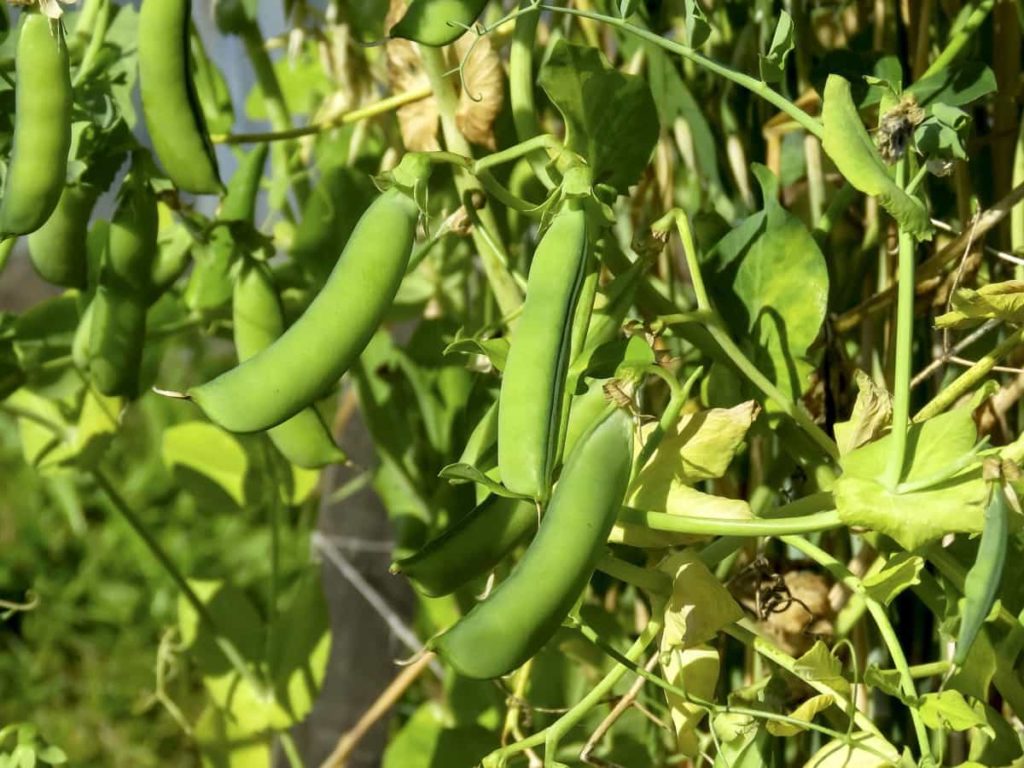
How many Pea seeds are in a hole?
You can add at least two Pea seeds per hole. Even 3 to 4 seeds per hole is fine. However, planting just one seed can leave you without Peas growing in place. Peas’ germination rate is only 60 to 80 percent, after all. Seeds should be planted between ½ to 1-inch depth and 2–3 inches apart. The space between the rows of Peas is at least 18 inches apart.
Should I start Peas indoors?
- Start your Peas indoors to get your Peas off to a good start, and don’t have to worry about pesky birds, rotting seeds, or problems at transplant.
- Indoors, growing Peas needs a lot of light and commitment, but when the time comes, you will enjoy the fresh pods you have grown yourself.
- Peas will grow faster if the soil temperature is 19°C to 21°C. In addition, you can speed up the germination process by soaking Peas for 24 to 48 hours before planting.
- The best soil temperature for growing Peas is ten °C to 24°C. Sow seeds in Peat pots 2 to 3 weeks before planting if you want to start planting indoors. Sow seeds 1/2 to 1 inch deep. In the garden, space Peas range from 2 to 3 inches.
Can Peas grow in pots?
- Peas are the best vegetable to grow in a container garden. They grow fast and don’t need much attention but will get a surprisingly large harvest for a little effort.
- You’ll need a container at least 14 inches wide and 14 inches deep, but the bigger the better, and you can grow more than one plant per container as long as you place them well. Fill your container with a potting mix of good quality and sow the Peas at a distance of 1 inch.
- You should plant Peas about 1 inch deep, and you can plant 5 to 8 Peas per container. You can put two Peas in a hole and thin as you see fit. It is a good practice to use two seeds if one does not grow.
What is the best mulch for Peas?
- Since Pea feeder roots run shallow, mulch is necessary to keep the soil around the roots moist and cool. When the seedlings are two inches long, apply clean straw, chopped leaves, or compost. As Pea plants mature, you can add more mulch to keep them happy.
- Wood chips are the common organic material used for Pea plant mulch. This type of mulch comes in a wide variety of colors and types. This is another type of mulch that provides great nutrition to your garden and plants as it breaks down.
What to spray on Peas for bugs?
- In the home garden, spray the leaves with soapy water, then wash them with clean water. Alternatively, use insecticidal soap spray.
- You can often control aphids by cleaning plant leaves or sprinkling them with a mild water solution and a few drops of dish soap. Soapy water should be applied every 2 to 3 days for two weeks.
- If powdery mildew is mild to moderate, try spraying Pea plants with plant-based horticultural oils such as neem oil. Never spray when the temperature is above 32°C. You can also spray Peas with a commercial fungicide at the first sign of the disease.
In case you missed it: How to Grow Oranges from Seed to Harvest: Check How this Guide Helps Beginners
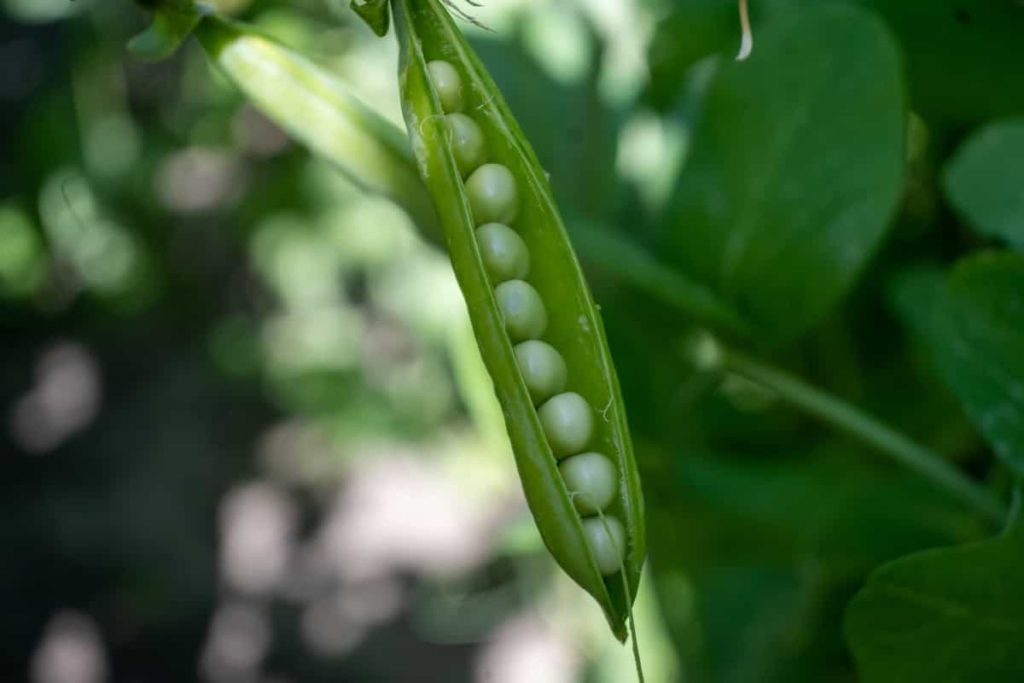
What type of soil do Peas grow best in?
- Peas thrive in fertile, loamy soil that is well drained. Pea plants are mostly tolerant of soil conditions, but avoiding heavy clay soil types is better. They grow best in soil with pH levels between 6.0 and 7.5.
- Peas prefer to grow in light, sandy loams though they can grow in other soil types. Good drainage is essential because the seeds and plants will rot if the soil is too wet.
- Peas grow well in almost any type of soil but perform best in fertile, somewhat sandy soils with good drainage. They prefer soils with neutral or slightly alkaline pH. If necessary, improve the soil before sowing by digging up to a depth of 6 to 8 inches and adding organic matter such as compost or dry manure.
Conclusion
Nothing beats the tenderness and taste of the home-grown Peas. Many different varieties of Peas, including snow Peas and sugar snap Peas, can be eaten whole without the need to shell them first. The good news is that all Pea varieties need the same basic growing conditions. As a result, peas are easy, high-achieving, and very delicious.
- How to Grow Hibiscus from Flower
- Plantation Ideas for Home Decoration: A Beginners Guide
- Flower Garden Designs and Layouts for Beginners
- Planting and Spacing Techniques in Papaya: A Beginner’s Guide
- Growing Gold: Essential Techniques for Planting Pineapples
- How to Make Kalanchoe Plant Bushy: Home Remedies and Solutions
- 11 Reasons Why Your Gardenia is Not Blooming: Home Remedies and Solutions
- Eco Elegance: The Guide to Designing a Drought-Tolerant Landscape
- Gardening on a Slope: Strategies for Hillside Landscaping
- Nourish and Flourish: Top Organic Mulches for Thriving House Plants
- Everything You Want to Know about Indian Mogra Flower: Discover Uses and Growing
- Green Thumb Success: Expert Tips for Cultivating Greenhouse Pumpkins All Year Round
- Maximize Growth & Flavor: The Ultimate Guide to Companion Planting in Herb Gardens
- How to Control Rhododendron Problems Naturally: Home Remedies and Organic Ways to Fix Them
- Natural Magic: The Remarkable Benefits of Cinnamon for Plants
- Best Steps to Revive Dying Tulip with Natural and Organic Treatment
- 10 Reasons Why Your Angel Trumpet is Not Blooming: Remedies and Treatment
- How to Fix Periwinkle Leaf and Flower-Related Problems: Natural Remedies and Solutions
- How to Fix Zinnias Leaf and Flower Problems: Discover Natural and Home Remedies
- Organic Steps to Induce Lemon Tree Flowers: A Comprehensive Guide
- Bloom Booster: Crafting the Perfect Homemade Bougainvillea Fertilizer
- Optimizing Growth: A Guide to Applying NPK Fertilizer for Potted Plants
- 10 Best Homemade Fertilizers for Rubber Plant: DIY Recipes and Application Method
- How to Boost Female Pumpkin Flowers: Effective Steps for More Flowers and High Yields
- Transform Your Indoor Garden: Top Benefits of Pink Salt for Houseplants
- 10 Best Homemade Fertilizers for Peacock Plants (Calathea): Easy DIY Guide
- Unlock Blooms: 9 Reasons Why Your Potted Chrysanthemum is Not Blooming
- 8 Reasons Why Your Potted Hibiscus is Not Blooming: Fix it with Simple Solutions
- Unlock Blooms: 9 Key Reasons Your Potted Frangipani Won’t Flower
- 10 Reasons Why Is My Ice Plant Not Blooming: Remedies and Treatment
- 10 Reasons Why My Potted Hydrangea Not Blooming: Treatment and Remedies
- 10 Reasons Why is My Wisteria Not Blooming: Remedies and Treatment
- 10 Reasons Why is My Goldfish Plant Not Blooming: Remedies and Treatment
- Maximize Your Space: Ultimate Guide to Balcony Gardening with Grow Bags
- 10 Reasons Why Your Iris is Not Blooming: Remedies and Treatment
- 10 Reasons Why Your Anthurium Plant is Not Blooming: Treatment and Remedies